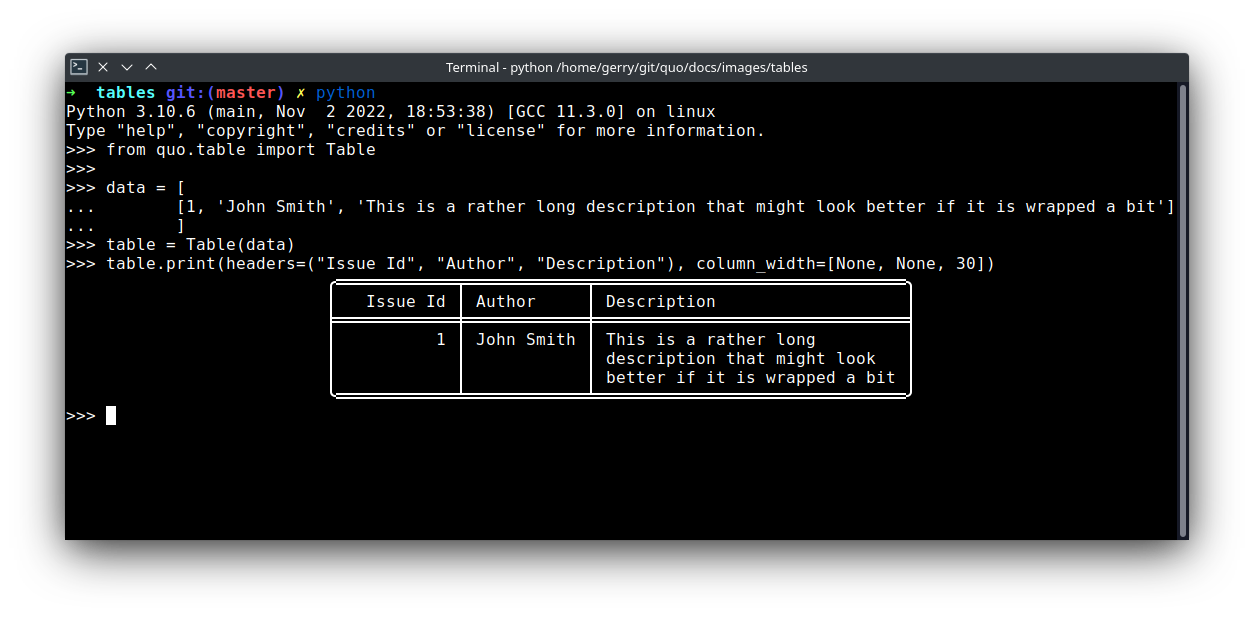Table
Printing tabular data
quo.table.Table function offers a number of configuration options to set the look and feel of the table, including how borders are rendered and the style and alignment of the columns.
Parameters
data- The first required argument. Can be a list-of-lists (or another iterable of iterables), a list of named tuples, a dictionary of iterables, an iterable of dictionaries, a two-dimensional NumPy array, NumPy record array, or a Pandas’ dataframe.
align-WindowAlignvalue or callable that return anWindowAlignvalue. alignment of content. i.eleft,centreorright.centreis the default value.
style- A style string.
theme- plain - Separates columns with a double space.
simple - like Pandoc simple_tables.
grid - similar to tables produced by Emacs table.el package.
fancy_grid - (Default theme) draws a grid using box-drawing characters.
pipe - Like tables in PHP Markdown Extra extension.
orgtbl - Like tables in Emacs org-mode and orgtbl-mode.
latex - Produces a tabular environment of LaTeX document markup.
presto - Like tables produce by the Presto CLI.
mediawiki - Produces a table markup used in Wikipedia and on other MediaWiki-based sites.
rst - Like a simple table format from reStructuredText.
Changed on v2022.4.3
from quo.table import Table
data = [
["Name", "Gender", "Age"],
["Alice", "F", 24],
["Bob", "M", 19],
["Dave", "M", 24]
]
table = Table(data)
table.print()

Table headers
To print nice column headers, supply the headers argument.
headers can be an explicit list of column headers.
if headers=”firstrow”, then the first row of data is used
if headers=”keys”, then dictionary keys or column indices are used otherwise a headerless table is produced.
from quo.table import Table
data = [
["Name", "Gender", "Age"],
["Alice", "F", 24],
["Bob", "M", 19],
["Dave", "M", 24]
]
table = Table(data)
table.print(headers="firstrow")
Column Widths and Line Wrapping
Table() will, by default, set the width of each column to the length of the longest element in that column. However, in situations where fields are expected to reasonably be too long to look good as a single line, :param:`column_width` can help automate word wrapping long fields.
from quo.table import Table
data = [
[1, 'John Smith', 'This is a rather long description that might look better if it is wrapped a bit']
]
table = Table(data)
table.print(headers=("Issue Id", "Author", "Description"), column_width=[None, None, 30])

Right aligned table
from quo.table import Table
data = [
["Name", "Gender", "Age"],
["Alice", "F", 24],
["Bob", "M", 19],
["Dave", "M", 24]
]
table = Table(data)
table.print(align="right")

Colored table
from quo.table import Table
data = [
["Name", "Gender", "Age"],
["Alice", "F", 24],
["Bob", "M", 19],
["Dave", "M", 24]
]
table = Table(data)
table.print(fg="green")

Grid table
from quo.table import Table
data = [
["Name", "Gender", "Age"],
["Alice", "F", 24],
["Bob", "M", 19],
["Dave", "M", 24]
]
table = Table(data)
table.print(theme="grid")
